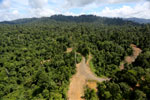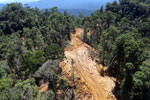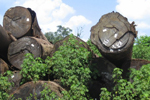Short of buying back logging concessions, switching from conventional logging approaches to reduced impact logging techniques across existing forestry concessions may be the best way boost biodiversity in areas earmarked for timber extraction, argues paper.

Logging in Borneo. Photos by Rhett A Butler.
Logging is one of the most important drivers of deforestation. However unlike other drivers, timber harvesting in the tropics rarely leads to outright forest clearing. Instead, logging drives deforestation more subtly. Successive harvests, especially when conducted in shorter-than-prescribed cycles, diminishes the value of the forest as a timber-producing commodity, increasing the likelihood of its conversion for agriculture or plantations. At the same time, logging roads open up once remote areas of forest to speculators, colonists, farmers, ranchers, miners, and hunters, often accelerating pressure on areas both inside and around concessions. Finally conventional logging approaches can degrade the ecological function and resilience of a forest, leaving it more vulnerable to disease, invasive species, drought, fire, and edge effects like wind damage.
For these reasons, environmentalists have long raised concerns about expansion of logging operations into old-growth forests. First-time logging of primary forests has been seen as an enabler of deforestation and therefore a threat to biodiversity and critical ecosystem services. Accordingly, such forests have been rated high priorities for conservation efforts as well as new zero deforestation policies increasingly being adopted in some sectors. Protecting old-growth forests remains a collective rallying cry for many activists.
Yet some four million square kilometers of tropical forest — an area half the size of the contiguous United States — is already set aside for logging, making it the single biggest land use in tropical forests worldwide. Does that mean these areas — which represent roughly a sixth of tree cover in the tropics — are a lost cause for conservation? The answer is no, as demonstrated by a large body of studies showing the selectively logged forests can sustain high levels of biodiversity, store large amounts of carbon, and retain critical ecosystems functions.

Logged forest gives way to oil palm plantations in Malaysia
However not every logged forest is created equal. Some may be degraded to the point where they are little more than scrub, while others may be nearly indistinguishable from primary forests from an ecological standpoint. Unsurprisingly, logging intensity has been identified as a key factor in how much biodiversity persists after timber harvesting. A study published in Current Biology this past July concluded that heavily logged forests were more likely to be biologically impoverished relative to lightly logged forests. Certain groups — mammals, amphibians, butterflies, dung beetles, and ants — are particularly sensitive to increases in logging intensity.
But looking only at logging intensity may not tell the whole story, argues a new study, also published in Current Biology. Like the July paper, the new research is also based on a meta-analysis of other research (41 studies), but it focuses on the type of logging, specifically whether reduced-impact logging techniques — like carefully planned logging roads, directional felling, winching, and pre-harvest inventories — are employed. It concludes that utilizing these techniques can significantly improve the prospects for wildlife within logging concessions.
“Our analyses reveal the effects of reduced-impact logging to be consistently lower than those of conventional logging, with smaller shifts in species abundance under reduced-impact logging,” write the authors, led by Jake Bicknell of the University of Kent. “Although our study shows that best practice forestry estates should not be considered equal in conservation value to primary forests, our analyses suggest that implementing reduced-impact logging more widely would result in substantial gains for biodiversity compared to the status quo.”

Beyond biodiversity conservation, the researchers note that adoption of reduced-impact logging techniques across the tropics’ four million square kilometers of forests would reduce carbon emissions by 160 million metric tons per year, or roughly a tenth of total emissions from deforestation. It might also bolster primary forest conservation relative to approaches that blindly emphasize low intensity logging, which could ultimately put more old-growth forest at risk of exploitation.
“Focusing on lower logging intensity alone could result in larger expanses of primary forest being logged to meet timber demand,” the authors write. “This may be incompatible with forestry economics as it would likely reduce profits. Furthermore, expanding the logged area would be unfavorable for conservation, as more biodiversity is retained where high harvest intensities are combined with the sparing of primary forest reserves, rather than universally harvesting at lower intensities. By contrast, our study suggests that even at high harvest intensities, reduced-impact logging will result in lower impacts than conventional logging, providing strong justification to improve logging practices.”

Logging operation in Malaysian Borneo
Improving logging practices however may be a tall order. Presently less than five percent of timber production forests have been RIL certified, much of which has come under the Forest Stewardship Council (FSC) standard, which mandates reduced-impact logging, but has no blanket prohibition against first-time logging of old-growth forests. Higher upfront costs and uncertain market demand has limited wider adoption by the industry.
The researchers therefore suggest governments and consumers provide active encouragement through policy and their buying decisions.
“Action is required among governments of tropical timber producer and consumer states to insist on best practice forestry,” they write.
“The guidelines are already in place, the logging techniques are available, and the expertise exists, so there is little excuse for timber companies not to implement RIL,” added Bicknell in a statement. “Economically, RIL can bring greater profits to timber companies over the long term, although the initial expenses may be slightly greater than with conventional practices.
“The issue is now advocating the diverse benefits of RIL to stimulate widespread uptake of the techniques. If policy makers and companies respond to the growing scientific evidence-base and move away from the business-as-usual scenario, then I am confident that future prospects for tropical forests and the biodiversity they contain will be much improved.”
CITATION: Jake E. Bicknell, Matthew J. Struebig, David P. Edwards, and Zoe G. Davies (2014). Improved timber harvest techniques maintain biodiversity in tropical forests. Current Biology Vol 24 No 23 R1120.
Related articles
FSC meeting weighs old-growth forest protection, smallholder participation

(09/11/2014) The Forest Stewardship Council (FSC), a body that sets social and environmental certification criteria for forestry products, is weighing measures that could step up protection for old-growth forests and make it easier for indigenous people and traditional forest communities to qualify for certification. The measures are set for a vote this week at the body’s General Assembly, which is held every three years to establish and revise criteria that underpin the standard.
How do we save the world’s vanishing old-growth forests?

(08/26/2014) There’s nothing in the world like a primary forest, which has never been industrially logged or cleared by humans. They are often described as cathedral-like, due to pillar-like trees and carpet-like undergrowth. Yet, the world’s primary forests—also known as old-growth forests—are falling every year, and policy-makers are not doing enough to stop it.

(08/15/2014) Among Russia’s forested lands lie intact forest landscapes (or IFLs). These IFLs are large swaths of unbroken, old growth forests that encompass at least 50,000 hectares, harbor high biodiversity, and have remained mostly undisturbed by development. However, less than 10 percent of the world’s IFLs are currently protected. Now, a new report reveals Russia’s IFLs may be threatened by certified sustainable logging companies.
Ecologists are underestimating the impacts of rainforest logging

(07/31/2014) Ecologists may be underestimating the impact of logging in old-growth tropical forests by failing to account for subtleties in how different animal groups respond to the intensity of timber extraction, argues a paper published today in the journal Current Biology. The study, led by Zuzana Burivalova of ETH Zurich, is based on a meta-analysis of 48 studies that evaluated the impact of selective logging on mammals, birds, amphibians, and invertebrates in tropical forests.
Reduced impact logging failing to cut emissions in Indonesia

(02/10/2014) Advocates for reduced impact logging in tropical forests often make a case that better forest management cuts carbon emissions relative to traditional forms of timber harvesting. While the argument for altering logging approaches to limit forest damage makes intuitive sense, a new study suggests that the carbon benefits may not bear out in practice.
Next big idea in forest conservation? Incentivizing keeping primary forests intact

(02/07/2014) Much of Dr. Corey Bradshaw’s work has a singular aim: to keep primary habitats and functioning ecosystems intact. According to Bradshaw, the existing system of carbon trading rules needs to be changed so that primary forests are given a higher value than other forms of land use. ‘Nothing, can replace primary vegetation, both in terms of biodiversity value and other ecosystem services.’
Old-growth trees store half rainforest carbon

(08/07/2013) Large trees store store up to half the above-ground biomass in tropical forests, reiterating their importance in buffering against climate change, finds a study published in Global Ecology and Biogeography. The research, which involved dozens of scientists from more than 40 institutions, is based on data from nearly 200,000 individual trees across 120 lowland rainforest sites in Africa, Asia, and Latin America. It found that carbon storage by big trees varies across tropical forest regions, but is substantial in all forests.
Experts: sustainable logging in rainforests impossible

(07/19/2012) Industrial logging in primary tropical forests that is both sustainable and profitable is impossible, argues a new study in Bioscience, which finds that the ecology of tropical hardwoods makes logging with truly sustainable practices not only impractical, but completely unprofitable. Given this, the researchers recommend industrial logging subsidies be dropped from the UN’s Reducing Emissions from Deforestation and Forest Degradation (REDD+) program. The study, which adds to the growing debate about the role of logging in tropical forests, counters recent research making the case that well-managed logging in old-growth rainforests could provide a “middle way” between conservation and outright conversion of forests to monocultures or pasture.